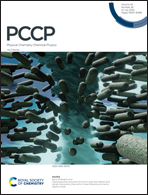Studying the effects of carbon nanotube contents on stretch-induced crystallization behavior of polyethylene/carbon nanotube nanocomposites using molecular dynamics simulations†
Abstract
In the present work, we used molecular dynamics simulations to study the effects of carbon nanotube (CNT) contents on stretch-induced crystallization behavior in CNT filled polyethylene systems. During high-temperature stretching, the stretching is responsible for the orientation of CNTs, which then facilitates segment orientation and conformational transition from the gauche-conformation into the trans-conformation in interfacial regions. The systems with higher CNT contents have a higher degree of orientation and higher contents of trans-conformation during stretching, resulting in the formation of more precursors. During subsequent crystallization, the initial crystallization rate increases with the increase of the CNT content due to the increase in precursor contents in interfacial regions. However, after the CNT content exceeds a certain value, a filler network would be formed by CNTs, which can restrict chain movements and then lead to a decrease in the overall crystallization rate in the systems with high CNT contents.



 Please wait while we load your content...
Please wait while we load your content...